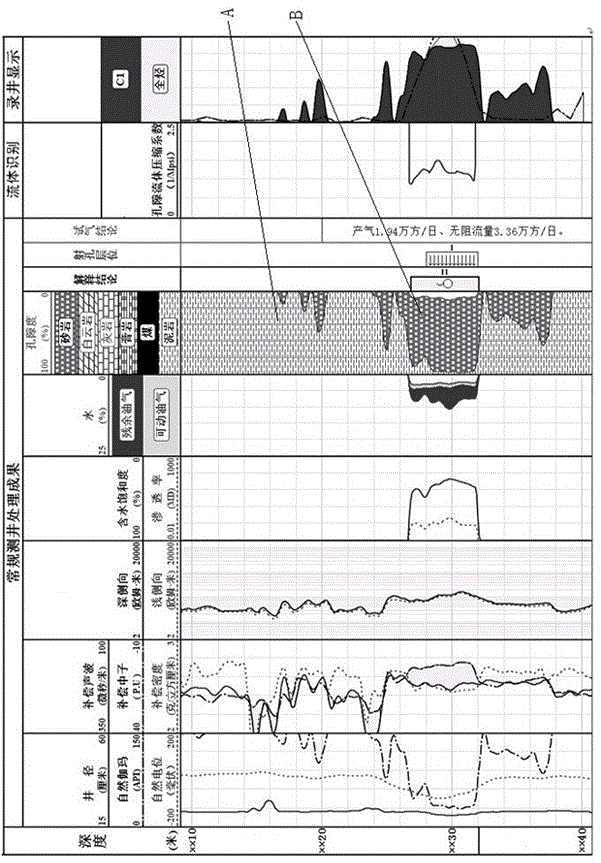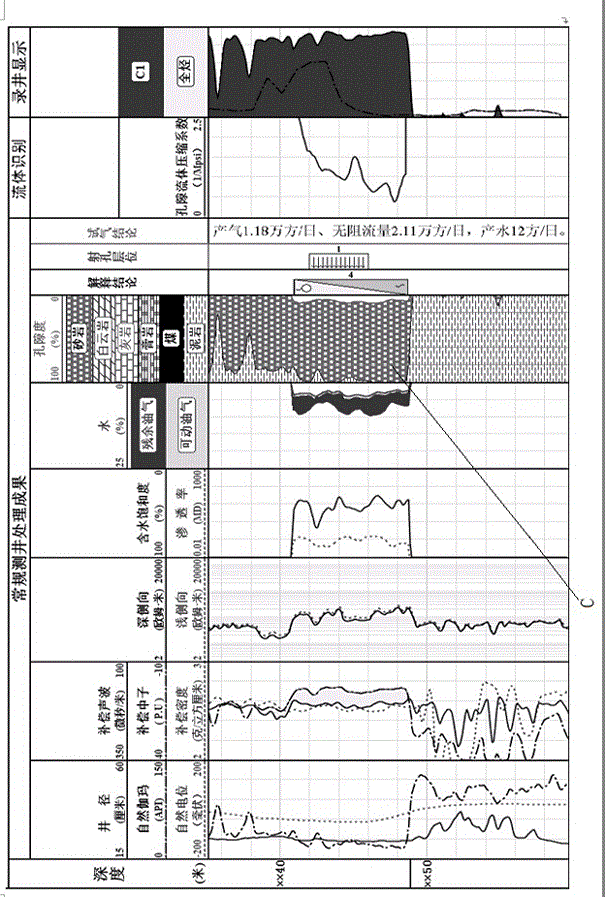Method for judging tight sandstone gas reservoir based on compressibility factor of pore fluid
A technology of compressibility and pore fluid, applied in geophysical measurements, instruments, etc., can solve the problem of low recognition accuracy, and achieve the effect of improving comprehensiveness, highlighting the difference between gas and water, and broadening the application field.
- Summary
- Abstract
- Description
- Claims
- Application Information
AI Technical Summary
Problems solved by technology
Method used
Image
Examples
Embodiment 1
[0042] As the best implementation mode of the present invention, it discloses a method for discriminating tight sandstone gas layers by pore fluid compressibility, which is characterized in that: the compressional wave time difference and shear wave time difference provided by array acoustic logging data, and the density logging data provide The formation density is the input information, and the formation bulk modulus is calculated to derive the formation compressibility coefficient. Combined with the formation volume model, the pore fluid compressibility coefficient is derived, and finally the fluid compressibility coefficient is used to judge whether it is a tight sandstone gas layer.
[0043] The specific steps are as follows:
[0044] a. Determine the compressibility factor of the formation
[0045] Assume that the formation bulk modulus is K b , the formula for calculating the bulk modulus of the formation is:
[0046] (1)
[0047] where ρ b is the formation densit...
Embodiment 2
[0068] Such as figure 1 As shown, it is an example of identifying tight sandstone gas layers in a certain area. The lithology of No. 11 reservoir in the figure is green-gray pebble-bearing medium sandstone B. From the results of conventional logging processing, it can be seen that the average porosity of the formation is 8.3%, and the average permeability The rate is 0.22×10 -3 μm 2 . The second pore fluid compressibility from the right shows that the pore fluid compressibility of this layer is mainly distributed in the range of 1.20-2.25 (1 / mpsi), indicating a gas layer; the third oil test conclusion from the right shows that this Layers produce pure gas 1.94×10 4 m 3 / d, to verify the correctness of the method.
Embodiment 3
[0070] Such as figure 2 As shown, it is an example of identification of tight sandstone gas-water layers in a certain area. The lithology of No. 4 reservoir in the figure is gray-white gas-bearing pebble-bearing coarse sandstone C. From the results of conventional logging processing, it can be seen that the average porosity of the formation is 8.7%. Average permeability 0.14×10 -3 μm 2 . The second pore fluid compressibility coefficient from the right shows that the pore fluid compressibility coefficient of the No. 4 reservoir is mainly distributed in the range of 0.65-1.85 (1 / mpsi), showing the characteristics of "upper gas and lower water", and the identification conclusion is determined as a gas-water layer . The conclusion of the third oil test from the right shows that the gas production in this layer is 1.18×10 4 m 3 / d, water production 12m 3 / d, to verify the correctness of the method.
PUM
 Login to View More
Login to View More Abstract
Description
Claims
Application Information
 Login to View More
Login to View More - R&D
- Intellectual Property
- Life Sciences
- Materials
- Tech Scout
- Unparalleled Data Quality
- Higher Quality Content
- 60% Fewer Hallucinations
Browse by: Latest US Patents, China's latest patents, Technical Efficacy Thesaurus, Application Domain, Technology Topic, Popular Technical Reports.
© 2025 PatSnap. All rights reserved.Legal|Privacy policy|Modern Slavery Act Transparency Statement|Sitemap|About US| Contact US: help@patsnap.com


